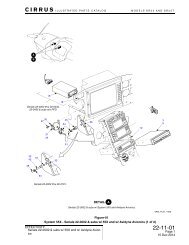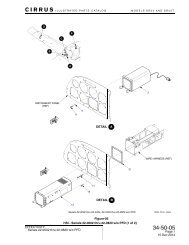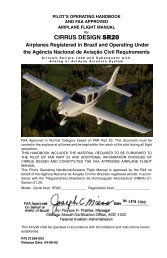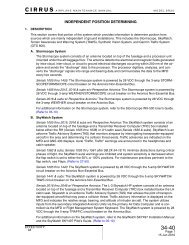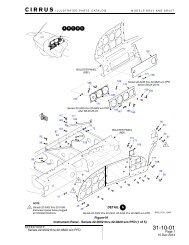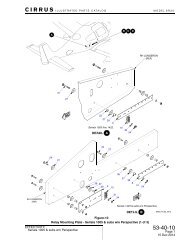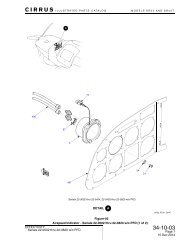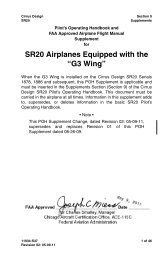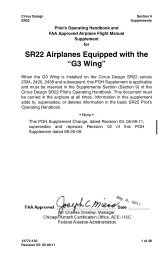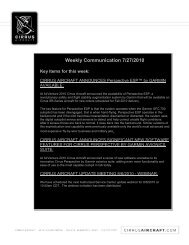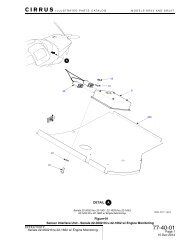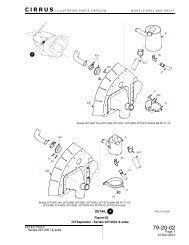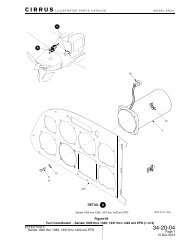Commercial Operation of Small Aircraft Electrical Loading Shedding Procedure
11934-S44 - Cirrus Design Authorized Service Center Home
11934-S44 - Cirrus Design Authorized Service Center Home
You also want an ePaper? Increase the reach of your titles
YUMPU automatically turns print PDFs into web optimized ePapers that Google loves.
Cirrus Design Section 9<br />
SR20<br />
Supplements<br />
Pilot’s Operating Handbook and<br />
FAA Approved Airplane Flight Manual<br />
Supplement<br />
for<br />
14 Code <strong>of</strong> Federal Regulations (CFR) Part 135<br />
<strong>Commercial</strong> <strong>Operation</strong> <strong>of</strong> <strong>Small</strong> <strong>Aircraft</strong><br />
<strong>Electrical</strong> <strong>Loading</strong> <strong>Shedding</strong> <strong>Procedure</strong><br />
<strong>Aircraft</strong> Serials with Avidyne PFD/MFD Avionics<br />
This supplement provides the necessary guidance for load shed in the<br />
event <strong>of</strong> a primary electrical generating source failure in accordance<br />
with 14 CFR Section 135.163(f).<br />
When the Cirrus Design SR20 aircraft is being operated under the<br />
provisions 14 CFR 135, this Supplement is applicable and must be<br />
inserted in the Supplements section (Section 9) <strong>of</strong> the Cirrus Design<br />
SR20 Pilot's Operating Handbook (Handbook). Information in this<br />
Supplement adds to, supersedes, or deletes information in the basic<br />
handbook.<br />
P/N 11934-S44 1 <strong>of</strong> 6<br />
Original Issue: 06-13-09
Section 9<br />
Supplements<br />
Section 1 - General<br />
No Change.<br />
Cirrus Design<br />
SR20<br />
2 <strong>of</strong> 6 P/N 11934-S44<br />
Original Issue: 06-13-09
Cirrus Design Section 9<br />
SR20<br />
Supplements<br />
Section 2 - Limitations<br />
Kinds <strong>of</strong> <strong>Operation</strong> Equipment List<br />
<strong>Aircraft</strong> Serial Numbers 1005 thru 2016 before SB2X-33-03 Rev 1 or<br />
later, LED Position/Strobe Assembly Installation:<br />
System, Instrument, and/or Equipment<br />
VFR<br />
Day<br />
Kinds <strong>of</strong> <strong>Operation</strong><br />
VFR<br />
Nt.<br />
IFR<br />
Day<br />
Lights<br />
LED Position/Strobe Assembly 1 1 1 1<br />
IFR<br />
Nt.<br />
P/N 11934-S44 3 <strong>of</strong> 6<br />
Original Issue: 06-13-09
Section 9<br />
Supplements<br />
Section 3 - Emergency <strong>Procedure</strong>s<br />
Cirrus Design<br />
SR20<br />
ALT 1 Failure (Alt 1 Light Steady)<br />
Steady illumination indicates failure <strong>of</strong> alternator 1. Attempt to restore<br />
alternator. If alternator cannot be restored, it will be necessary to divert<br />
the flight to land within one hour.<br />
Loads on Main Buses, Non-essential Buses, and Ventilation Buses<br />
must be reduced and available equipment on these buses managed<br />
as necessary for flight conditions. Equipment essential for continued<br />
safe flight and landing will be powered by Alternator 2 and Battery 2<br />
through the Essential Buses. However, depending upon flight<br />
conditions, additional equipment is required.<br />
For 14 CFR 135 <strong>Operation</strong>s, the load shedding and equipment<br />
management in the following procedure will provide at least one-hour<br />
operating time on aircraft with a fully charged, 13.6 amp-hour battery<br />
(available from Cirrus Design Spare Parts Sales) in good condition for<br />
equipment required for emergency operation under 14 CFR 135.163(f)<br />
and meets the requirements <strong>of</strong> that paragraph.<br />
• Note •<br />
Circuit breakers that “PULL” should only be pulled and not<br />
reset.<br />
1. ALT 1 Master Switch ................................................................OFF<br />
2. Alternator 1 Circuit Breaker................................. Check and Reset<br />
3. ALT 1 Master Switch ................................................................. ON<br />
If alternator does not reset<br />
4. ALT 1 Master Switch ................................................................OFF<br />
5. Notify ATC <strong>of</strong> Alternator Failure and that transponder may be<br />
switched <strong>of</strong>f depending upon flight conditions.<br />
6. Autopilot ...........................................................................ENGAGE<br />
Use <strong>of</strong> autopilot will reduce work load and provide trim function.<br />
Expect a slight pitch change when autopilot is disengaged.<br />
7. NAV Lights ................................................................................ ON<br />
4 <strong>of</strong> 6 P/N 11934-S44<br />
Original Issue: 06-13-09
Cirrus Design Section 9<br />
SR20<br />
Supplements<br />
8. Reduce loads as required for flight conditions:<br />
a. Ventilation Fan ..................................................................OFF<br />
b. Convenience Outlet ................................Disconnect appliance<br />
c. Audio Panel .......................................................................OFF<br />
COM 1 will be supplied to pilot’s headset. Communication with<br />
passengers through audio panel will not be available.<br />
d. GPS/COM 2 ......................................................................OFF<br />
e. Fuel Pump .........................................................................OFF<br />
except for landing and switching tanks.<br />
f. Panel and Overhead Lights ...............................................OFF<br />
g. Landing Light.....................................................................OFF<br />
• WARNING •<br />
Do not shed loads from Avionics Essential, Essential, or<br />
Essential 2 Bus row.<br />
h. Skywatch/TAWS Circuit Breaker...................................... PULL<br />
i. Weather/Stmscpe Circuit Breaker ................................... PULL<br />
j. MFD Circuit Breaker........................................................ PULL<br />
9. Assess flight conditions:<br />
If in Visual Meteorological Conditions (VMC):<br />
a. Pitot Heat...........................................................................OFF<br />
If in Instrument Meteorological Conditions (IMC) or visible<br />
moisture:<br />
a. Pitot Heat.............................................................................ON<br />
b. Strobe Lights .....................................................................OFF<br />
10. Replan flight for a landing as soon as practical (within one hour) at<br />
a landing field with visual minimums. Increase landing speed 10<br />
KIAS for flaps up. Do not use landing lights.<br />
P/N 11934-S44 5 <strong>of</strong> 6<br />
Original Issue: 06-13-09
Section 9<br />
Cirrus Design<br />
Supplements<br />
SR20<br />
Section 3A - Abnormal <strong>Procedure</strong>s<br />
No Change.<br />
Section 4 - Normal <strong>Procedure</strong>s<br />
No Change.<br />
Section 5 - Performance Data<br />
No Change.<br />
Section 6 – Weight and Balance<br />
No Change.<br />
Section 7 – Airplane and Systems Description<br />
No Change.<br />
Section 8 – Handling, Service, & Maintenance<br />
No Change.<br />
Section 9 – Supplements<br />
No Change.<br />
Section 10 – Safety Information<br />
No Change.<br />
6 <strong>of</strong> 6 P/N 11934-S44<br />
Original Issue: 06-13-09



